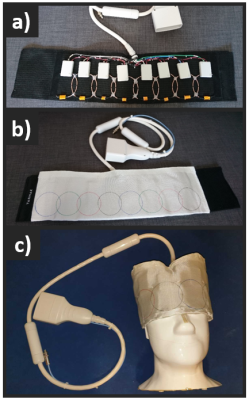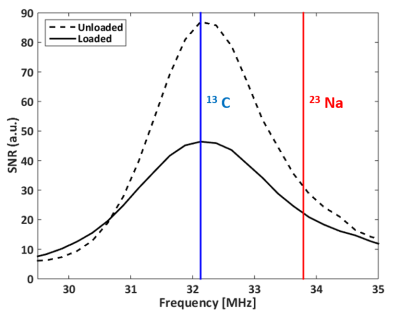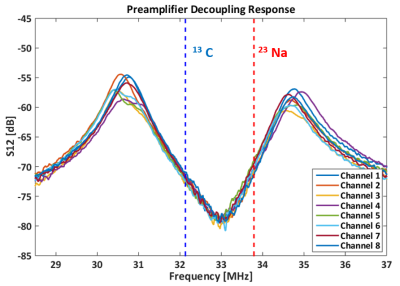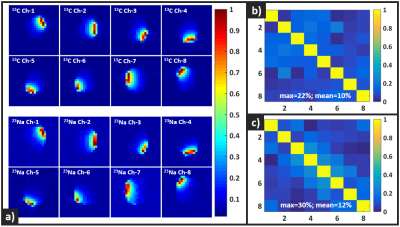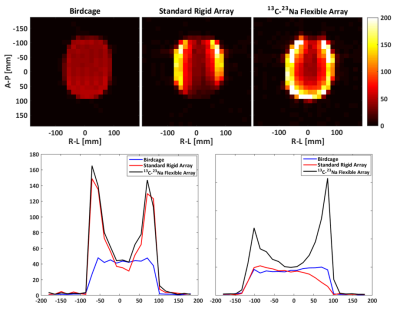2509
Flexible 8-Channel Array for Hyperpolarized 13C at 3T (32.1 MHz), with Nearly Identical 23Na (33.8 MHz) Sensitivity Profiles1Department of Health Technology, Technical University of Denmark (DTU), Kgs. Lyngby, Denmark, 2Department of Electrical Engineering, Technical University of Denmark (DTU), Kgs. Lyngby, Denmark, 3Department of Physiology, Anatomy and Genetics, University of Oxford, Oxford, United Kingdom, 4Oxford Centre for Magnetic Resonance, University of Oxford, Oxford, United Kingdom, 5Department of Radiology, The Churchill Hospital, Oxford University Hospitals NHS Trust, Oxford, United Kingdom, 6The MR Research Center, Department of Clinical Medicine, Aarhus University, Aarhus, Denmark
Synopsis
We describe the design of a flexible coil array tuned optimally for 13C MRI at 3T (32.1 MHz), but with the coil coupling coefficients matched to be nearly identical at the 13C and 23Na (33.8 MHz) frequencies. In this way, the array provides the means to obtain accurate sensitivity profiles for hyperpolarized 13C imaging from the high 23Na naturally present in biological tissue. We show the feasibility of this approach, and compare the performance to other 13C coils, showing that the 13C SNR provided by this array is not compromised despite the modification to equalize the 13C and 23Na profiles.
Introduction
Hyperpolarized 13C imaging is an emerging technique for accurate diagnosis of metabolic disorders1. Due to the short-lived nature of the hyperpolarized nuclei, parallel imaging is especially beneficial and has been successfully applied in hyperpolarized imaging with promising results2. However, it is not desirable to use the hyperpolarized signal to estimate the 13C sensitivity profiles, and therefore some a priori estimation is needed. We propose to take advantage of the proximity of the 23Na frequency (1.7 MHz difference at 3T) to design a 13C receive array with a coupling matrix tailored such that the coupling levels are nearly identical at 13C and 23Na. In this way, the sensitivity profiles are expected to be similar. Some work has already been done to estimate the transmit parameters of the 13C scans, from the 23Na naturally present in biological tissue3. However, for receive arrays, the translation between frequencies is more challenging due to the frequency response of the preamplifier decoupling. We propose an array where the preamplifier decoupling is adjusted such that the coupling levels are nearly identical at the two frequencies. The basis for this design relies on having a high level of preamplifier decoupling, which can be obtained by mismatching the LNA to a higher impedance than the noise optimal in a controlled way4. Then, one can tune its response to an intermediate frequency between 13C and 23Na, and the coupling levels will still be low at both frequencies.Materials and Methods
The coil array is made up of 8 loops of 80 mm of diameter each. Each loop is built with standard flexible copper coax (RG-316), where the outer jacket is used to create the conductive loop. The array is shown in Fig. 1. The measured unloaded-to-loaded Q-ratio for the individual elements is QU/QL=260/80 when loaded with a human head. The SNR variation as a function of frequency was measured for one of the array elements, as described in Fig. 2. The crucial design feature of the proposed array is that the level of decoupling provided by the mismatched preamplifiers should be as similar as possible for the two frequencies of interest. In this array, we match the coils to an impedance higher than the noise optimal of the LNA (WanTCom) in order to achieve preamplifier decoupling levels above 30 dB. With this level of decoupling, a sacrifice can be done at the 13C frequency in order to match the coupling matrix at the 23Na frequency. MRS measurements (CSI, 360×360×150 mm3, matrix size = 24 × 24) were performed on a human head phantom filled with ethylene glycol doped with 17g/L of NaCl to emulate tissue loading. The TR used for the 13C acquisition was 1 s (total acquisition time = 9 min 36 s), while for 23Na, TR of 219 ms and 8 averages were used (total acquisition time 16 min 40 s). The sensitivity profiles and noise correlation matrices were measured for the two different nuclei. Finally, a 13C SNR evaluation was performed5 by comparison with a birdcage volume coil (RAPID Biomedical) and a rigid 8-channel array (GE Healthcare). All measurements were performed using a dedicated 13C transmit coil of the clamshell type (RAPID Biomedical).Results and Discussion
The results from Fig. 2 show that for a loaded coil, the SNR difference between the 13C and 23Na frequencies is about a factor of 2. In Fig. 3, the measured preamplifier decoupling response is shown, where the coupling level is observed to be nearly identical for all 8 channels. We also see that the difference between the optimal decoupling (obtained around 33 MHz) and the decoupling at 13C and 23Na frequencies is 6 - 7 dB. This is the level of coupling that we sacrifice with this design compared to an array optimized for 13C. In Fig. 4a, the measured sensitivity profiles are shown. The similarities between the profiles at both frequencies are clear, though small variations are still present, which is expected due to the different B1+ generated by the transmit coil at the two frequencies3. Figs. 4b and 4c show the measured noise correlation matrices, which in general show low values and good agreement of the average correlation levels between 13C and 23Na. Finally, Fig. 5 shows the 13C SNR level of the array compared to a volume coil and to a traditional array. This result confirms that the extra coupling that we accept at the 13C frequency with this method has no notable effect on the final 13C SNR performance. Regarding the SNR of the 23Na acquisition, it should be mentioned that the flip angle used during this measurement is estimated to be 22° because the transmit coil used is not tuned for 23Na, and its efficiency at that frequency is low.Conclusion
A flexible 8-channel receive array for 13C at 3T (32.1 MHz) has been built in such a way that the 13C sensitivity profiles can be accurately obtained from measurements on the 23Na nuclei that at 3T is only 1.7 MHz apart (33.8 MHz). We show that this design approach can provide a means to obtain accurate 13C sensitivity profiles in cases where the low natural abundance of 13C makes it impossible.Acknowledgements
No acknowledgement found.References
1. Nelson SJ, Kurhanewicz J, Vigneron DB, et al. Metabolic Imaging of Patients with Prostate Cancer Using Hyperpolarized [1-13C]Pyruvate. Sci Transl Med. 2013;5(198):198ra108-ra198ra108. doi:10.1126/scitranslmed.3006070.
2. Olin RB, Sánchez-Heredia JD, Schulte RF, et al. Three-dimensional accelerated acquisition for hyperpolarized 13C MR with blipped stack-of-spirals and conjugate-gradient SENSE. Magn Reson Med. n/a(n/a). doi:10.1002/mrm.28171.
3. Grist JT, Hansen ESS, Sánchez‐Heredia JD, et al. Creating a clinical platform for carbon‐13 studies using the sodium‐23 and proton resonances. Magn Reson Med. 2020;84(4):1817-1827. doi:10.1002/mrm.28238.
4. Sánchez-Heredia JD, Johansen DH, Hansen RB, et al. Improved Decoupling for Low Frequency MRI Arrays Using Non-Conventional Preamplifier Impedance. IEEE Trans Biomed Eng. 2019;66(7):1940-1948. doi:10.1109/TBME.2018.2881203.
5. Sánchez-Heredia JD, Olin RB, McLean MA, et al. Multi-site benchmarking of clinical 13C RF coils at 3T. J Magn Reson. 2020;318:106798. doi:10.1016/j.jmr.2020.106798.
Figures
